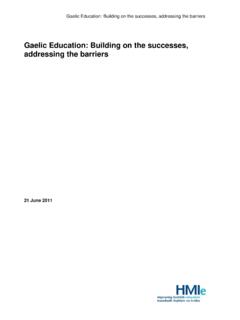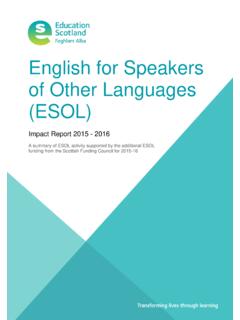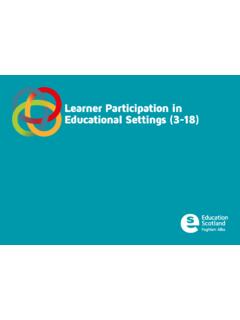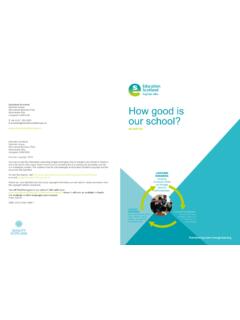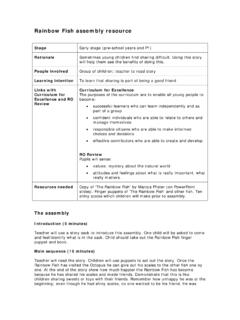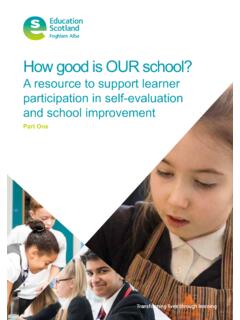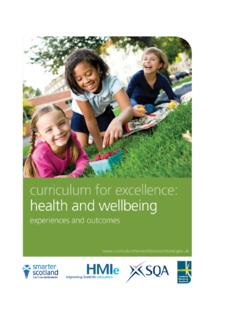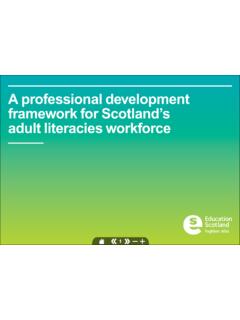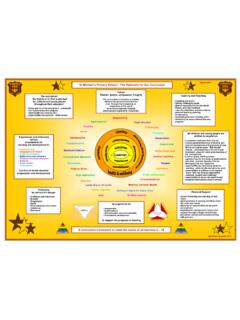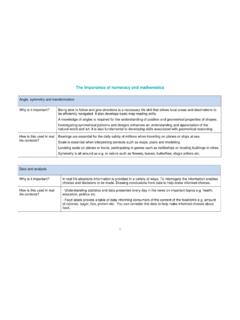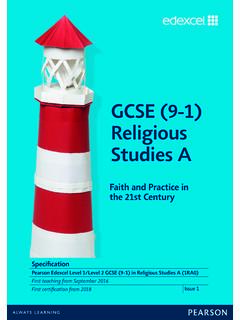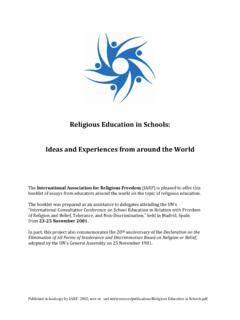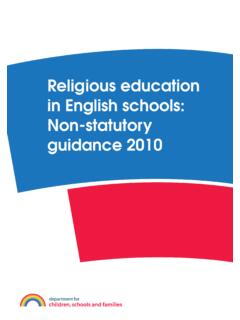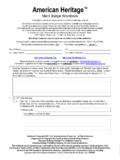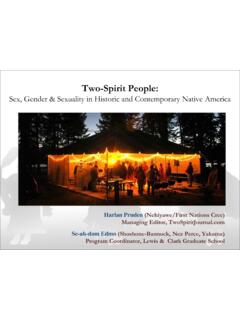Transcription of Religious and moral education
1 Religious and moral education Principles and practice Why is Religious and moral education important for all children and young people?1 What do children and young people achieve through learning in Religious and moral education ? Scotland is a nation whose people hold a wide range of beliefs from the many branches of the Christian faith represented throughout the land to the world s other major religions and to beliefs which lie outwith Religious traditions. Such diversity enriches the Scottish nation and serves as an inspiring and thought-provoking background for our children and young people to develop their own beliefs and values. Religious and moral education enables children and young people to explore the world s major religions and views which are independent of Religious belief and to consider the challenges posed by these beliefs and values.
2 It supports them in developing and reflecting upon their values and their capacity for moral judgement. Through developing awareness and appreciation of the value of each individual in a diverse society, Religious and moral education engenders responsible attitudes to other people. This awareness and appreciation will assist in counteracting prejudice and intolerance as children and young people consider issues such as sectarianism and discrimination more broadly. Religious and moral education is a process where children and young people engage in a search for meaning, value and purpose in life. This involves both the exploration of beliefs and values and the study of how such beliefs and values are expressed. Building the Curriculum 1 Children and young people must become aware that beliefs and values are fundamental to families and to the fabric of society in communities, local and global.
3 There is an intrinsic value in learning about religion as well as learning from religion, as children and young people develop their understanding of diversity in our society and their own roles in it. The skills of reflection and critical thinking and an enhanced understanding of the beliefs and values of others are all crucial in assisting in this process. Learning through Religious and moral education enables children and young people to: recognise religion as an important expression of human experience learn about and from the beliefs, values, practices and traditions of Christianity and the world religions selected for study, other traditions, and viewpoints independent of Religious belief explore and develop knowledge and understanding of religions, recognising the place of Christianity in the Scottish context investigate and understand the responses which Religious and non- Religious views can offer to questions about the nature and meaning of life recognise and understand Religious diversity and the importance of religion in society develop respect for others and an understanding of beliefs and practices which are different from their own explore and establish values such as wisdom, justice.
4 Compassion and integrity and engage in the development of and reflection upon their own moral values develop their beliefs, attitudes, values and practices through reflection, discovery and critical evaluation develop the skills of reflection, discernment, critical thinking and deciding how to act when making moral decisions make a positive difference to the world by putting their beliefs and values into action establish a firm foundation for lifelong learning, further learning and adult life. Religious and moral education is therefore an essential part of every child or young person s educational experience. 1 Religious education has a statutory position in Scottish education , relating to schools but not to pre-school centres. Religious and moral education : principles and practice 1 How are the Religious and moral education experiences and outcomes organised?
5 The experiences and outcomes allow opportunities for personalisation and choice, depth and reflection. The experiences and outcomes are structured within three organisers to enable teachers to plan learning about and through Christianity and those other world religions which are selected for study, and to plan for the development of beliefs and values. For the major religions, the lines of development are Beliefs, Values and issues, and Practices and traditions. The experiences and outcomes relating to the development by children and young people of their own beliefs and values do not form a separate context for planning but should be intertwined with the experiences and outcomes for Christianity and the world religions selected for study. The fourth level outcomes have been designed to approximate to SCQF level 4. Why is there an emphasis on Christianity within the Religious and moral education curriculum?
6 When planning for Religious and moral education , schools will take account of the communities and the context in which the children and young people live and learn. Through their learning in Religious and moral education all children and young people will develop an understanding of Christianity, which has shaped the history and traditions of Scotland and continues to exert an influence on national life. It is also a fundamental principle that all children and young people throughout Scotland will consider a range of faiths and views, whatever their own situation and local context. Indeed, the experiences and outcomes will lead to children and young people, as they develop, extending their learning far beyond the local context to national and international contexts. What are the features of effective learning and teaching in Religious and moral education ?
7 Learning should be coherent, progressive and meaningful, and should be planned for and taught in ways that encourage learners to recognise that the knowledge, skills and attitudes identified are inextricably linked. These aspirations can only be achieved through high quality teaching and learning and the establishment of a supportive climate for learning. All teachers have an important role in modelling and promoting an ethos of inclusion and respect for individuals. In planning learning and teaching in Religious and moral education , teachers will be able to: sensitively take account of and value the Religious and cultural diversity within their own local communities, using relevant contexts which are familiar to young people actively encourage children and young people to participate in service to others develop, through knowledge and understanding and discussion and active debate, an ability to understand other people s beliefs draw upon a variety of approaches including active learning and planned, purposeful play encourage the development of enquiry and critical thinking skills create opportunities for the development of problem -solving skills build in time for personal reflection and encourage discussion in depth and debate provide opportunities for collaborative and independent learning take account of the faith background.
8 Circumstances and developmental stage of the children and young people and their capacity to engage with complex ideas recognise and build on the considerable scope for connections between themes and learning in Religious and moral education and other areas of the curriculum make appropriate and imaginative use of technology build on the principles of Assessment is for Learning. Active learning approaches, including collaborative learning, will encourage children and young people to discuss and share ideas, experiences and moral challenges in a variety of ways, as well as develop skills for life and work such as communication, working with others and problem-solving. Religious and moral education : principles and practice 2 Teachers will ensure that children and young people from within any faith are treated with sensitivity. While some may wish to discuss their faith, others may not.
9 Teachers should not assume that any child or young person should be automatically drawn upon as a source of information. Viewpoints independent of Religious belief can be considered within the learning and teaching approaches adopted for Christianity and world religions selected for study. The experiences and outcomes in development of beliefs and values support the development of broader understanding and permeate learning and teaching. Above all, it is the teacher who brings the inspiration and challenge critical to achieving our aspirations for all young people. How do I plan for an appropriate range of religions and also take account of viewpoints which are independent of Religious belief? In addition to study of Christianity, decisions have to be made about which world religions will be selected for study to develop depth of understanding.
10 It is important to acknowledge local circumstances and community expectations and to involve parents in decision making. It is also important to avoid superficial coverage of too many religions and too many aspects which is potentially confusing. With this in mind it may be appropriate in many primary schools to focus on a maximum of two world religions in addition to Christianity. However, while one or more religions will be studied in depth, teachers may also want to draw upon carefully selected aspects of other religions, possibly in the context of interdisciplinary learning. The context of study of world religions including Christianity will often lead teachers to appropriate points where viewpoints independent of Religious belief, values and practices, and traditions can be considered. An illustrative example is that of the opportunity provided when exploring a religion s moral values or response to a social issue also to explore corresponding or alternative moral values which are independent of Religious belief.
